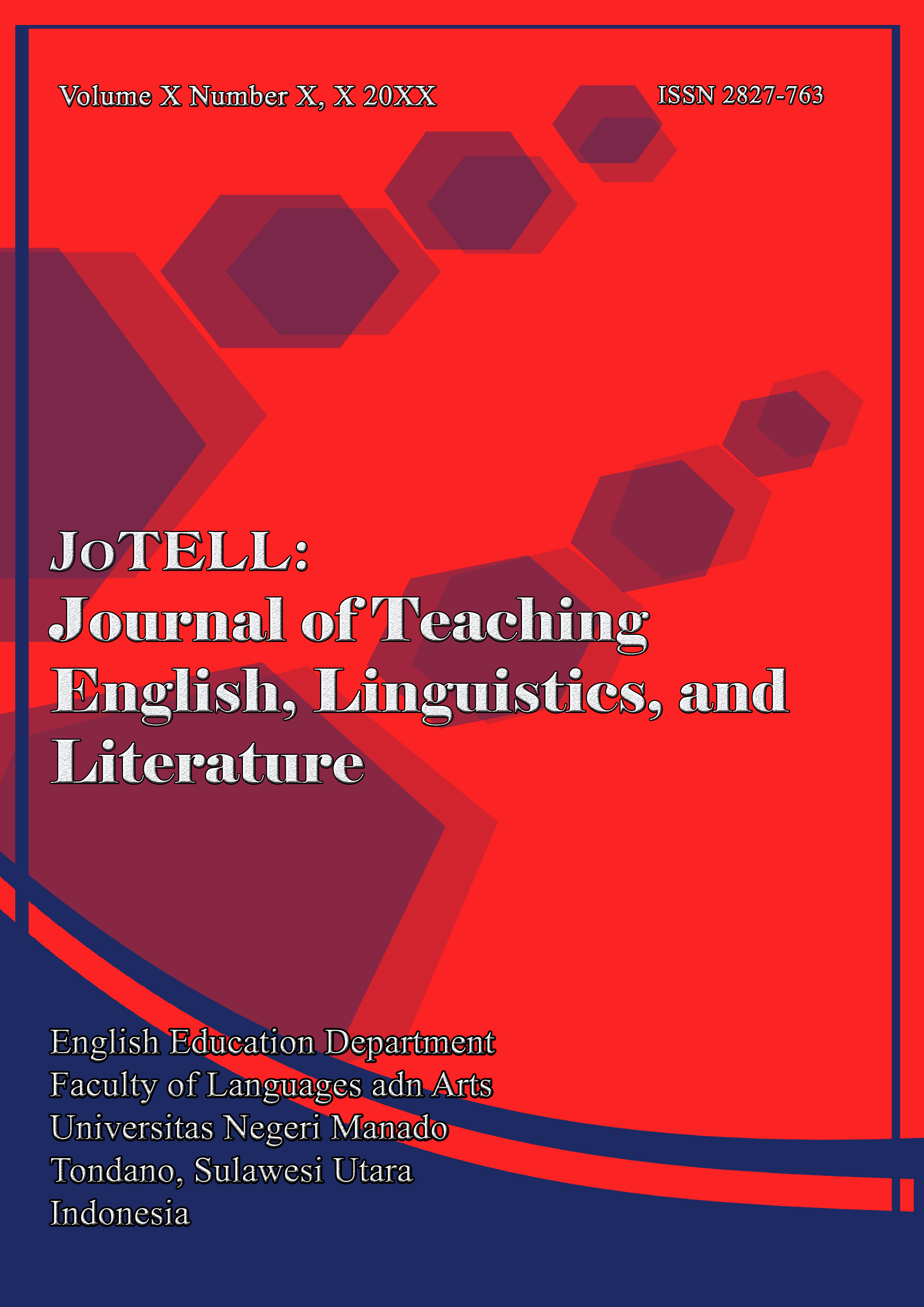INCREASING STUDENTS’ VOCABULARY BY USING WORD CARDS AT SMP N 6 KAKAS
DOI:
https://doi.org/10.36582/jotell.v1i6.4213Keywords:
Vocabulary, Word Cards , Increasing, Junior High SchoolAbstract
Teaching vocabulary by using Word Cards, makes students are able to find new vocabulary from what they are seeing and the spelling from the Word Cards. The purpose of this study was to find out whether the use of Word Cards is able to increase students’ vocabulary. The students at SMP NEGERI 6 KAKAS in academic year 2019/2020 were chosen as the subject of this study, specified to the seventh grade that consisted of 18 students. This research used pre-experimental design with one group pre-test and post-test. This study consisted in five meetings. First the researcher gave a pretest next treatment and the last posttest. The technique in collecting data used test as instrument in form of matching item test consisted with 25 numbers. The result of this study found that Word Cards was effective in increasing students’ vocabulary where post-test was higher than pre-test. The mean score pre-test was 8.27 and the mean score of post-test was 14.61. It can be stated that Word Card is considered effective to increase students’ vocabulary
References
Ababneh, S. 2013. New Vocabulary in English. Journal of Education and Practice. Jordanian University Press.
Andries, F., Hammp, P., Rombepajung, P., & Lengkoan, F. (2019, November). The Application of Special Self-Made Word Card for Vocabulary Teaching Particularly Irregular Verbs. In International Conference on Social Science 2019 (ICSS 2019) (pp. 969-971). Atlantis Press.
Bintz, William. (2011). Teaching Vocabulary across the Curriculum. Middle School Journal.
Dengah, O., Maru, M. G., & Lolowang, I. (2021). OPPOSING VIEWS IN WEBBER’S JESUS CHRIST SUPERSTAR: A DECONSTRUCTION ANALYSIS. Journal of English Language and Literature Teaching, 4(2).
Ellis, R. (2008). The Study of Second Language Acquisition. Oxford University Press.
Gerungan, N., Muntuuntu, M., & Rorimpandey, R. (2022). AN ANALYSIS OF STUDENTS’LEVEL OF CRITICAL THINKING IN FINAL EXAM. JoTELL: Journal of Teaching English, Linguistics, and Literature, 1(1), 157-174.
Hamalik, Oemar. 1993. Media pendidikan. Bandung: PT. Citra Aditya Bakti.
Hampp, P. L., Kumayas, T. A., & Lengkoan, F. (2021). Synthesizing Grammar and Structure Problems Faced by Indonesian TOEFL Takers. Jurnal Pendidikan Bahasa Inggris undiksha, 9(1).
Hornby, A.S. 1995. Oxford Advance Learners’ Dictionary. Oxford New York. Oxford University Press.
Lengkoan, F., Andries, F. A., & Tatipang, D. P. (2022). A STUDY ON LISTENING PROBLEMS FACED BY STUDENTS OF HIGHER EDUCATION. Globish: An English-Indonesian Journal for English, Education, and Culture, 11(1), 41-50.
Mehta, N. K (2009). Vocabulary Teaching: Effective Methodologies. The internet TESL journal.
Mohammad A. L (2017) Research Method on Language Leaning: an introduction. Universitas Negeri Malang.
Nation, I.S.P. (1994) learning vocabulary in another language. Cambridge University Press.
Paranduk, R., Rombepajung, P., & Karisi, Y. (2021). ENHANCING STUDENTS’SPEAKING SKILL IN FACING THE REVOLUTION ERA 4.0. Journal of English Culture, Language, Literature and Education, 9(2), 103-116.
Paranduk, R., & Karisi, Y. (2020). The effectiveness of non-verbal communication in teaching and learning english: a systematic review. Journal of English Culture, Language, Literature and Education, 8(2), 140-154.
Ramelan, 1984. Introduction to linguistics Analysis, Semarang: IKIP Semarang Press.
Rorimpandey, R. (2019). Youtube Videos in Teaching Basic Listening. Journal of English Language and Literature Teaching, 4(1).
Sabanari, V. W., Rombepajung, P., & Kumayas, T. (2022). USING PICTURES TO IMPROVE STUDENTS’ENGLISH VOCABULARY AT SEVENTH GRADE OF SMP NEGERI 1 SIAU TIMUR SELATAN. JoTELL: Journal of Teaching English, Linguistics, and Literature, 1(3), 417-430.
Samola, N. F., Andries, F. A., Kumayas, T. A., & Rorimpandey, R. S. (2018). Morphological Analysis of Slang Words Spoken by Transgender Community in Manado. In 1st International Conference on Social Sciences (ICSS 2018) (pp. 859-863). Atlantis Press.
Schmitt, N. (1999). Vocabulary learning strategies. In N. Schmitt, & M. McCarthy (Eds), Vocabulary description, acquisition and pedagogy (pp.19 9-227).Cambridge: Cambridge University Press
Sekeon, E., Rombepajung, P., & Kumayas, T. (2022). STUDENTS’PERCEPTION TOWARD ENGLISH SONG AS A LEARNING MEDIA OF LISTENING COMPREHENSION. JoTELL: Journal of Teaching English, Linguistics, and Literature, 1(1), 23-43.
Somba, Y., Liando, N., & Kumayas, T. (2022). A STUDY ON TYPES OF VOCABULARY TASKS IN EFL TEXTBOOK ENGLISH ON THE SKY 1. JoTELL: Journal of Teaching English, Linguistics, and Literature, 1(4), 528-549.
Syarif, H. (2011) Enriching Students’ Vocabulary by using Flash Cards. Jakarta, Universitas Islam Negeri.
Tangiduk, Y. K., Samola, N., & Rorimpandey, R. (2021). OPTIMIZING STUDENTS’READING COMPREHENSION OF DESCRIPTIVE TEXT THROUGH E-LEARNING METHOD WITH WHATSAPP APPLICATION AT STUDENTS OF SMA NEGERI 1 BUKO. Journal of English Culture, Language, Literature and Education, 9(1), 1-16.
Teppa, R., Rorimpandey, R., & Posumah, J. (2022). IMPROVING STUDENTS’LISTENING SKILL BY USING SONGS’LYRICS A STUDY CONDUCTED AT SMAN 1 MELONGUANE. JoTELL: Journal of Teaching English, Linguistics, and Literature, 1(2), 244-260.
Wullur, A. E., Liando, N. V., & Rorimpandey, R. (2021). IMPROVING STUDENTS’MOTIVATION IN STUDYING ENGLISH USING AUDIO-LINGUAL METHOD. Journal of English Language and Literature Teaching, 5(1).












